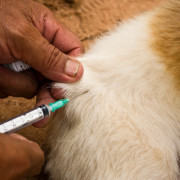- Science News
- Health
- Dr Deborah Nadal: Why a rigid rabies elimination strategy can struggle to take hold in a world of local complexities
Dr Deborah Nadal: Why a rigid rabies elimination strategy can struggle to take hold in a world of local complexities

Dr Deborah Nadal. Image: Rebecca Rodrigues
Dr Deborah Nadal is an affiliate researcher at the University of Glasgow, where she works on rabies-related projects, and a consultant for the Department of Control of Neglected Tropical Diseases of the World Health Organization (WHO). Her PhD research on the co-existence between people, free-roaming animals, and the rabies virus in urban India got turned into an award-winning book. Her two main research areas are health and animals (human and non-human), with a particular interest in how different species can contribute to each other’s physical, mental, and social wellbeing, especially in impoverished settings. Now, she tells us more about the need to understand local perceptions of rabies to tackle this deadly disease efficiently and sustainably.
What inspired you to become a researcher?
Becoming a researcher was not in my plans until rather recently. When, as a pre-school kid, I was asked what my job would be, I always replied “Licia Colò”. She is an Italian TV hostess famous for travel and animal shows. To the young me, she was the job. Then, as a school kid, the veterinary profession was my dream. In fact, my book is dedicated to this dream. But during my school years, my fascination with India started to grow as well and, despite the skepticism of my family – who had never gone to university, let alone to India – I decided to enroll in south Asian studies.
I realized I wanted to try to become a researcher only when I decided to prepare my PhD application. Yet, things didn’t go as planned, because soon before my departure for fieldwork in a tribal area of eastern India, two Italians were kidnapped by a guerrilla group active in the area, so the Indian government decided to limit the presence of foreigners there. I decided to go to India anyway, and to find another research topic directly in the field.
Nowadays, I continue to be a researcher also because of the importance that my four-year-old daughter attributes to what she describes as my job: talking to people in India to make sure that they and their dogs are healthy and happy.
Can you tell us about the latest research you’re working on?
My postdoc research, ‘Where Rabies Is Not a Disease. Bridging Healthworlds to Improve Mutual Understanding and Prevention of Rabies’ (funded by the European Union's Horizon 2020 research and innovation program under a Marie Skłodowska-Curie Grant), looked at how dog bites and dog and human rabies are understood, experienced, talked about, and managed in rural western India. Scientific knowledge tells us that mass dog vaccination and vaccination of bitten individuals are efficient, when combined, to control rabies in the dog population and eliminate dog-mediated human deaths. This strategy grounds on the concept of 'one health', according to which the health of humans, animals, and the environment is interdependent. Even though this concept appears rather intuitive and hence universal, due to reasons that may be cultural, religious, political, historical, or economic, different communities may have different ideas about how to safeguard human-animal-environmental health.
For example, in the Indian state of Gujarat, there is a Hindu community who, in the event of a dog biting a person or their livestock, resorts to Hadkai Mata, one of the very few rabies-related deities in any world religion. Through interviews with staff at Hadkai Mata temples, I discovered that rabies is understood as a social illness caused by the goddess's wish to correct, through infected dog bites, misbehaving people and restore positive interpersonal relations. If people undergo the necessary process of moral growth expected by the goddess and the community, the goddess can even cure rabies (which, from a biological perspective, is incurable). For Hadkai Mata believers, this belief results in the deprioritization of human vaccination and the disagreement with dog vaccination.
In your opinion, why is your research important?
It seems easy to assume that, since rabies is such a horrifying disease, everybody understands the rabies risk, and takes action, in the same way. But, for example, we already know that in places where dog culling has long – and in vain – been used to control rabies, communities may now be suspicious about the real purpose of dog vaccination campaigns.
Similarly, in the community where I work, which suffers from harsh social discrimination by neighbouring groups, the strict adherence to social norms such as not lying or not stealing is considered crucial to uplifting the status of the community in the eyes of the rest of society. In fact, Hadkai Mata believers say that dog bites generally happen as the consequence of wrong actions like dishonouring promises or overindulging in alcohol.
Understanding local perceptions is key to the design of context-tailored, hence feasible and sustained rabies elimination strategies.
Are there any common misconceptions about this area of research? How would you address them?
A common misperception is that local communities lack scientific information and hence need to be educated. Therefore, it is not uncommon to see research projects where people’s knowledge is tested through, for example, closed-ended questions like “Is rabies lethal: yes or no?”. While this kind of information can be useful, it cannot be exhaustive, because questions like this only capture what local people know of biomedical knowledge. But there are many other kinds of knowledge.
We need to ask people open-ended questions as well, because this would allow us to enter, albeit partially, the perspective they see things from.
What are some of the areas of research you’d like to see tackled in the years ahead?
I think we need more community-based participatory research, so local communities can be part of research projects not only as research subjects, but as research designers and field researchers too, alongside professional researchers. This has many benefits, such as making sure that research addresses actual community needs and allowing collected data to be analysed locally, by merging the external understanding of researchers and the internal explanations of local people.
How has open science benefited the reach and impact of your research?
I will follow up on the previous answer here. Another important ingredient of community-based participatory research is the creation of a research team that includes local professional researchers. By local, I don’t mean just Indian – for this project, I have worked with Indian colleagues – but people who feel part of the social, cultural, and religious setting this research is located in. My paper in Frontiers is the first academic work on the role that Hadkai Mata plays in the management of rabies. By being open access, I hope that this paper reaches scholars who already know Hadkai Mata from the inside of her community.







